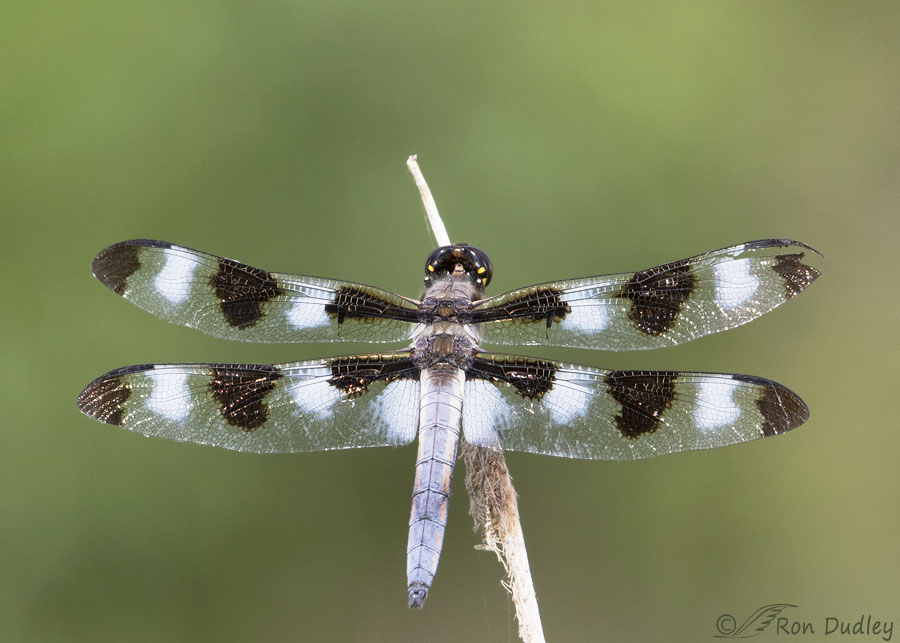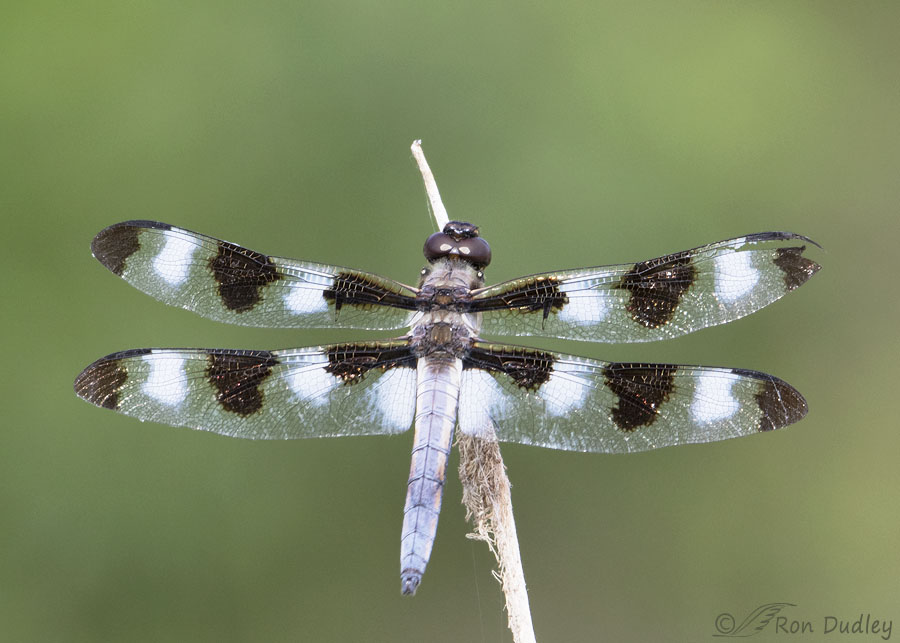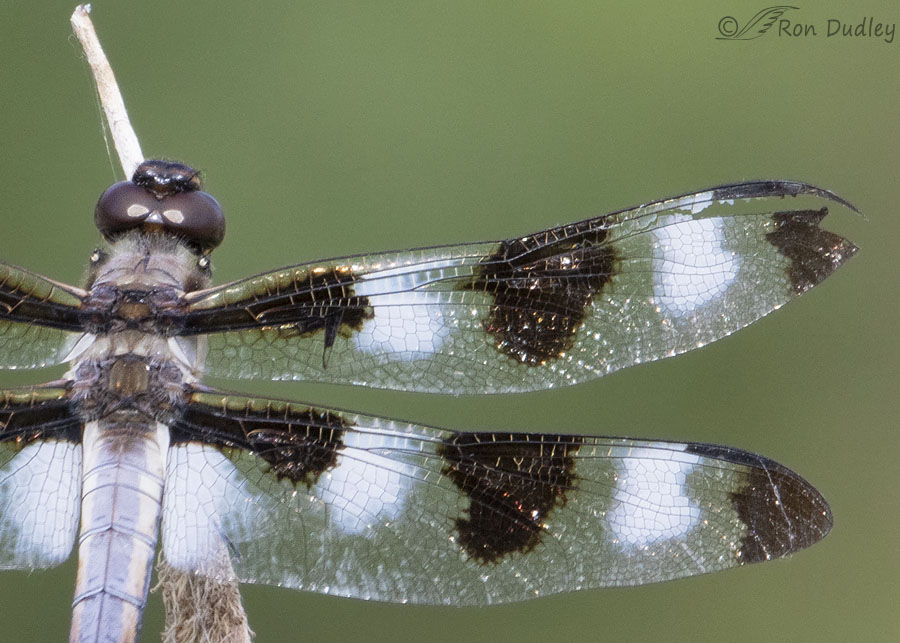Something a little different from me this morning. Quite a bit different, actually.

1/640, f/10, ISO 800, Canon 7D Mark II, Canon EF 500mm f/4L IS II USM + EF 1.4 III Extender, not set up
Six days ago while attempting to photograph birds in a remote area of Box Elder County I used my super telephoto ‘birding lens’ to photograph a Twelve-spotted Skimmer dragonfly, a male I believe, on top of a cattail.
Despite some wear and tear I think he’s a beauty and I was very happy with the detail I got even though he filled significantly less than half the frame in the original image.
One thing baffles me a little. In the first few shots I took of him there were yellow spots on the rear of his compound eyes.

1/1250, f/10, ISO 800, Canon 7D Mark II, Canon EF 500mm f/4L IS II USM + EF 1.4 III Extender, not set up
But they disappeared in later shots I took of him. My best guess is that they were reflections but if so I’m surprised they were yellow. The sun perhaps?
Of the many shots I took of him this is the only one (compare this photo to the previous one) where that large and distinctive ‘bump’ in front of his compound eyes could be seen. I’m guessing it’s mouthparts, labrum perhaps?, that he raised for just a moment.

A very large crop of the previous image gives us a better look at both the phantom ‘bump’ and the wear and tear on his right forewing.
Whether or not this is macro photography depends on your definition. Some would argue that it isn’t macro photography unless you’re using a macro lens. But by another definition it’s macro photography if the subject is larger than life size in either the original image or the finished photograph. These photos are close enough to qualify as macro for me.
One of the several significant advantages of using a telephoto lens for macro purposes is that you can still be relatively far away from your subject when taking the photo instead of being so close you’re likely to scare it off. I find it to be particularly useful for insects.
One thing you have to be careful about is shooting from a distance closer than the minimum focusing distance of your lens. With my lens that distance is 12.1′. And as counterintuitive as it may seem it’s important to remember that using a teleconverter does not, I repeat does not, increase your MFD.
So when I’m shooting macro with my telephoto I’m always using my 1.4 tc.
Ron
Addendum: My friend Jim DeWitt suggests that the ‘phantom bump’ is likely the frons. I’m no entomologist but that seems more than plausible to me.


Great to see some Skimmer shots. I photograph dragonflies (and bugs of all sorts) all the time with my tele lens too. I can get close to some species of dragonflies and damselflies with my dedicated macro lens but I still seem to end up with the best shots from a middling quality 70-300mm tele. These dorsal (back) view images are the ones I seem to get easiest most of the time so lately my challenge to myself has been to go for other angles. These creatures are endlessly engaging from every direction. Where I often photograph them they will land repeatedly on the same high perch so if I scare them off occasionally but move myself to a different spot while they are buzzing around they will often come right back to the same high spot and position and I am then afforded a new angle. Their heads are very mobile…always in motion as they are perched. In the first shot (with the yellow dots showing) the Skimmer’s head is clearly tilted downward…possibly to its extreme in that direction. In the second it is tilted up and so the frons (but if you–like me–are old enough to remember Jimmie Durante you will prefer “schnoz”) is in view. There’s no 12 Spotted Skimmers in my personal bug museum so I can’t check for sure but I think those spots are pigmented areas on the back of the head which is just visible in your first image as a narrow, shiny black strip surrounding the back of the eye. The Widow Skimmers in my collection have similar markings on the backs of their heads and they are clearly visible on the heads of several species in my copy of Kathy Biggs “Common Dragonflies of California”.
I admire “Feathered Photography” posts every day, and would love to see
more insect subjects, too……I had NO IDEA a telephoto lens could be used
to such advantage with macro/micro subjects ( yup, I get a little confused
in this realm also ! )
Thank you, Kris. Maybe there will be a few more insect posts in the future. This dragonfly inspired me to try more often.
I am also a big fan of dragonflies – and love the details. Oooh, ahhh and thank you.
Many, many thank yous. For a change. Not.
Thank you, EC.
Wonderful photos and information. Dragon flies were my first fascination as a kid. We used to find the nymphs in the creek that runs through my parents yard.
Some of those dragonfly nymphal stages are pretty scary looking, especially for a kid. Thanks, April.
He is a little the worse for wear, but still a stunner. I’m a fan of “wingy-thingies” of all sorts and these photos do not disappoint. Such an interesting, close-up look at features you’d have no idea about just watching them flit above water. As for survival and reproduction, I’d bet these guys are every bit as sturdy as butterflies—I had a mama Monarch laying eggs like crazy last year despite one badly torn wing. She was around for several days after ….
Yup, they’re tough, Chris. They have to be. Good for your mama Monarch!
Macro, micro, Manny, Moe, or Jack — I don’t care what you call these shots other than FANTASTIC! You caught so much detail and the light is perfect to show off those wings and compound eyes. Stunning!
I hope that his wing injury doesn’t impact him too much and that he’s still able to feed and reproduce. He is quite the handsome specimen — those genes need to be passed on!
I think he was doing just fine, Marty. Butterfly and dragonfly wings can get pretty beat up during a season.
Well, your super super-telephoto macro photos took me down another rabbit hole, getting the insect books out and googling. Amazing creatures, complex anatomy. Who knew the Twelve-spotted Skimmer’s wings have a boot-shaped anal loop? (not where you think).
“boot-shaped anal loop”
Now I’ll be visiting that rabbit hole too. Thanks a lot, Lyle…
Ahhhhhhh!!!!! Love these shots!!
I have a close-up lens and can’t get the clarity and beauty that you caught! Man, if I survive this pandemic I am buying a 7D. Yes, I know it is in the lens and the person behind the lens, but at my age cut me a little slack, at least I can fantasize!! VBG!
Thanks very much, Dick. You’re right, in this case it’s mostly the lens rather than the camera or the photographer.
Great photos! It is fun to get photos of these fellas…some co-operate and others play catch me if you can. I do not have the teleconverter for my 100/400 but it singly gets me what I want…yes sometimes just moving a bit in your seat just sharpens everything up.
Kathy, sometimes I don’t think of moving back in my seat when I need to,. And it always seems to happen with the shots with the most potential.
I am such a fan of dragonflies that I have a tattoo of one. This fella is really striking!
Now THAT’S a sign of an addiction to dragonflies!
Very interesting Ron. I have taken dragonfly photos for years. Of course with my Canon super-zoom bridge camera I am much closer than you would be. We have five lakes here and of course there are dragonflies everywhere around them.
Everett, I need to remember to take more photos of them when I have the opportunity. Sometimes I think I focus on feathers too much…
Very nice shots Ron. Using my 100×400 with 1.4x teleconverter, I regularly use this technique on bees, spiders, moths, butterflies, and any other insect that I can find. I find that it’s far easier to get near the insects and more of the insect will be in focus, versus if I was using my 100mm macro lens. Cool pics!
You make a good point about depth of field, Rick.
I don’t have a lot of experience shooting macro with my big lens so for these shots I went to f/10 and crossed my fingers. Thankfully the dragonfly was broadside to me so I didn’t need a lot of DOF.
WOW! Stunning photos – Grinning ear to ear with these. Love the detail and “sparkle”. Seems to be a little different angle on his head on the first one with the yellow spots – like it’s tipped forward – something in the eye itself for the color? Whatever – it’s neat! Didn’t know the teleconverter does NOT affect MFD. Of course, being at a distance I’ve just never thought about it and moved until I was further away than the MFD
Love the detail and “sparkle”. Seems to be a little different angle on his head on the first one with the yellow spots – like it’s tipped forward – something in the eye itself for the color? Whatever – it’s neat! Didn’t know the teleconverter does NOT affect MFD. Of course, being at a distance I’ve just never thought about it and moved until I was further away than the MFD 
Judy, as I’m sure you know it can be hard to tell sometimes if you’re just a little closer than your MFD based on sharpness through the viewfinder. I try to allow a little extra wiggle room whenever I can. Sometimes all it takes is for me to sit back a few more inches in my pickup seat.
That’s for sure!